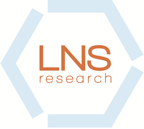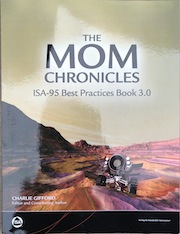
by Gary Mintchell | Jul 23, 2015 | Automation, Internet of Things, Operations Management
 Tim Sowell, Schneider Electric (Wonderware) vp and fellow, has been writing a weekly blog that I report on for a while now. His Operations Management Systems Evolution blog is always thoughtful and informative.
Tim Sowell, Schneider Electric (Wonderware) vp and fellow, has been writing a weekly blog that I report on for a while now. His Operations Management Systems Evolution blog is always thoughtful and informative.
Recently, I have discovered another Schneider Electric blog, this one by someone whom I do not know (I think)–Gregory Conary.
Each take a look at the Industrial Internet of Things in these posts.
Conary’s recent post discussed the “business opportunities we are seeing emerge from this megatrend.”
He cites information compiled by LNS Research, in its eBook Smart Connected Operations: Capturing the Business Value of the Industrial IoT. 47 per cent of respondents to its Manufacturing Operations Management (MOM) online survey indicated that they did not expect to invest in IoT technologies in the “foreseeable future”. A further 19 per cent indicated that they did not expect to invest in IoT technologies in the next 12 months.
Conary states, “Frankly I’m not surprised. IIoT seems to bring with it the hype of something that will take a long time to adopt. In some cases I think this can be true. And while we are unclear on what time frame is meant by the term ‘foreseeable future’ referenced above, I believe there are business opportunities that can be capitalized on now and in the medium term. IIoT is more prevalent than we imagine. There are examples and business practices that we often don’t even recognize as being enabled by IIoT – things like increasing industrial performance and augmenting operators are two of the opportunities which can make a difference to your business now.”
Increased industrial performance
“Using data to improve industrial performance by connecting things to each other – this is happening now. How is it happening? Through wireless technologies, low cost sensors and using advanced analytics. In practice, this is a decision support system for complex manufacturing operations.”
I agree with Conary. We’ve had the foundation and platform for the Industrial Internet of Things for a long time. It just continues becoming more robust. As better data analytics algorithms are developed and better ways to communicate and display information are devised, then usefulness to manufacturing operators, maintenance technicians, engineers, and managers will increase dramatically.
Tim Sowell riffed off an article in Wired. “As the Internet of Things (IoT) continues its run as one of the most popular technology buzzwords of the year, the discussion has turned from what it is, to how to drive value from it, to the tactical: how to make it work.
We need to improve the speed and accuracy of big data analysis in order for IoT to live up to its promise. If we don’t, the consequences could be disastrous and could range from the annoying – like home appliances that don’t work together as advertised – to the life-threatening – pacemakers malfunctioning or hundred car pileups.”
Sowell adds this analysis, “This follows on from my discussion 2 weeks ago around the need to avoid just gathering data, vs gaining the proportional amount of knowledge and wisdom, which brings in a term you hear a lot ‘machine learning’.”
From Wired, “The realization of IoT depends on being able to gain the insights hidden in the vast and growing seas of data available. Since current approaches don’t scale to IoT volumes, the future realization of IoT’s promise is dependent on machine learning to find the patterns, correlations and anomalies that have the potential of enabling improvements in almost every facet of our daily lives.”
Sowell concludes, “In the industrial world this more applicable than nearly all industries, and in many cases we are already applying “machine levels” at different levels. A key part in the shift from ‘Information’ to ‘knowledge’ is having the tools to drill into historians based on events and to discover learnings and patterns. Once validated and discovered these are turned into ‘self-monitoring’ conditions to understand the current state of the device, and predict / recognize conditions well before they happen. Providing the ‘insight’ to make awareness and decisions where the machines/ devices are telling you where the opportunities are. But a key part of machine learning is that this knowledge in not a once off step, it is a continuous evolution leveraging the gathering history data and developing increased amounts of knowledge.”
Final thought
Both Conary and Sowell point directly to the new reality and to new challenges. We can now gather much more data than we can make sense of. As soon as we have those tools, we will provide better tools to operations and maintenance to improve plant performance.

by Gary Mintchell | Feb 3, 2015 | Operations Management, Software
 Mike Roberts at LNS Research has posted a blog 11 Tips for Stimulating Enterprise Software Adoption. Many, if not all, of these tips have been written about before. This is a useful compilation of them in one place. Reading between the lines, I wonder if he’s talking about putting in one of those huge, monolithic software solutions that, in reality, have a spotty record of installation and adoption. Even so, these are more important than ever.
Mike Roberts at LNS Research has posted a blog 11 Tips for Stimulating Enterprise Software Adoption. Many, if not all, of these tips have been written about before. This is a useful compilation of them in one place. Reading between the lines, I wonder if he’s talking about putting in one of those huge, monolithic software solutions that, in reality, have a spotty record of installation and adoption. Even so, these are more important than ever.
I’ll summarize a few here. Head over to the blog to catch them all along with their
- Ensure Executive Sponsorship and Buy-In for the Project
Executive sponsorship is key to getting budget approval for an enterprise software investment, but the role of leadership has to extend beyond that. One aspect that may facilitate executive buy-in and use is evaluating solutions with robust executive dashboards and reporting capabilities early on.
- Include Users in the Solution Selection Process Upfront
It’s important to not alienate the professionals who will actually use the solution from the processes of developing user requirements, selection, and coming up with a deployment plan.
- Put Together a Deployment Team to Support the Project over Its Lifecycle
Because every company has a unique set of IT resources and user requirements, it’s feasible to forecast on-the-fly adjustments will be required during the deployment to create a better user experience or to troubleshoot a system issue.
- Execute a Pilot Deployment before Transitioning Enterprise-Wide
It’s common for companies to initiate a deployment with a single module or two to attain early user feedback and get the process down.
- Identify & Empower “System Champions” to Support and Drive Adoption
Just like there are early adopters on the technology adoption lifecycle for consumer products, the same can be said in the business world.
- Invest in Change Management that Ensures Long-Term Adoption
Although leadership should anticipate some resistance, they should also have a plan for overcoming it.

by Gary Mintchell | Jan 14, 2015 | Data Management, Manufacturing IT, Operations Management, Software
 One of my prognostications from my last post on 2015 prognostications riffing off Jim Pinto’s post, dealt with analytics. I think this will not only be big, it will be essential to making you and your manufacturing enterprise competitive.
One of my prognostications from my last post on 2015 prognostications riffing off Jim Pinto’s post, dealt with analytics. I think this will not only be big, it will be essential to making you and your manufacturing enterprise competitive.
Mark Davidson of LNS Research, just wrote about the subject, Enterprise Manufacturing Intelligence (EMI) software, on the LNS blog site.
He asks, “1) What are the business results that manufacturing/production companies are achieving utilizing these software capabilities? And 2) What should you and your company be doing in regard to the opportunities presented by these technologies?”
He correctly addresses the core capability—operational and business performance dashboards that provide timely information to different users and roles.
Are people using these now? “61% of companies in the LNS Research Manufacturing Operations Management (MOM) survey of over 550 professionals indicated that their companies either currently have EMI dashboards or are planning to install them in the next year.”
Here’s why this is important. “The joint LNS Research and MESA ‘Metrics That Matter’ survey uncovered a significant difference in average annual improvements in the costs of producing a unit of goods. Current users of EMI software recorded 24.1% average annual improvements in Total Cost per Unit Excluding Materials versus the 13.1% overall improvement of all respondents.” And, “Companies that have implemented EMI software solutions are experiencing 7.2% higher OEE performance than those who have not. The average OEE for those who have EMI solutions in place was 74, versus 69 for those who do not.”
Make sure your stars are aligned
And, his last thought, “It is imperative that you not only focus on these supporting new technologies, it’s important to also align your organization’s key resources: people and processes, along with your technology strategy.”
Check out Mark’s complete article. Then check out potential partners for implementing EMI applications. Let me know how you’re doing.

by Gary Mintchell | Nov 12, 2014 | News, Operations Management, Software

MOM Chronicles: ISA95 Best Practices
The International Society of Automation (ISA) Publications Department has awarded Charlie Gifford the Thomas G. Fisher Award of Excellence for a Standards-Based Reference Publication. The book, which Gifford assembled and edited, is “The MOM Chronicles: ISA-95 Best Practices Book 3.0”.
I have the book and highly recommend it to all who are trying to understand and implement the ideas and models of ISA95—the international standard for the integration of enterprise and control systems. Charlie is an internationally respected practitioner and teacher on manufacturing operations management (MOM).
Charlie offers this comment on the honor, “I sincerely thank ISA for this prominent award named for a distinguished man, Tom Fisher. As Primary Contributing Author and Chief Editor, I accept this award for all 50 contributing expert authors and reviewers of the ISA-95 Manufacturing Operations Management (MOM) Best Practices Working Group. This is the 2nd time the working group’s work products have been recognized for this award. In 2011, ‘When World Collide in Manufacturing Operations, Book 2.0’ was also selected. ISA continues to support the group’s work products of 23 applied technology white papers and 3 books. These documents enable manufacturing systems professionals worldwide to become a primary reference resource over the last 10 years.”
Here is a glimpse into MOM Chronicles:
- Chapter 1: Applying Global MOM Systems in a Manufacturing 2.0 Approach
- Chapter 2: The Role of Semantic Models in Smarter Industrial Operations
- Chapter 3: Applying Manufacturing Operations Models in a Discrete Hybrid Manufacturing Environment
- Chapter 4: Defining an Operations Systems Architecture
- Chapter 5: A Workflow-driven Approach to MOM
- Chapter 6: Scheduling Integration Using an ISA-95 Application in a Steel Plant
- Chapter 7: Intelligent Integration Interface: I3, A Real-world Application of ISA-95
Here’s a glimpse into When Worlds:
- Chapter 1: SOA for Manufacturing Overview
- Chapter 2: Data Architecture for MOM: The Manufacturing Master Data Approach
- Chapter 3: Building a Manufacturing Transformation Strategy with ISA-95 Methods
- Chapter 4: Work Process Management for Adaptive Manufacturing
- Chapter 5: B2MML, Integration Patterns, and Data Mapping
- Chapter 6: Integration of Manufacturing Intelligence with MOM
- Chapter 7: Lifecycle of Service Creation using the ISA-95 MOM
Charlie Gifford, PMP, is General Manager & Senior Advanced Manufacturing Consultant at Intelligent Manufacturing Institute, 21st Century Manufacturing Solutions LLC.

by Gary Mintchell | Oct 15, 2014 | Automation, Data Management, Manufacturing IT, News, Operations Management, Software, Technology
Furthering consolidation of the MES space, Siemens (the PLM division) announced agreement to acquire manufacturing software developer Camstar Systems. Siemens, in its press release, says “the acquisition will build on Siemens’ industrial digitalization strategy by broadening its integrated product development and production automation solutions for the electronics, semiconductor and medical device industries.”
I am a little surprised by the announcement, because I had the impression that Siemens was downplaying the MES space. No comments, just observation. But the PLM group has been pretty aggressively pursuing the Siemens dream of digital manufacturing–something that fits within the German government’s initiative of “Industrie 4.0”. The group’s leadership is solid and its ability to integrate acquisitions is outstanding. This will be a real benefit for the company.
I asked noted industry analyst Julie Fraser, principal of Iyno Advisors, for an opinion. Here are her comments:
“There are always challenges with keeping product, sales and customer momentum after an acquisition, and small private company employees may not be comfortable in one of the largest companies in the world. I always worry about those “people-centric” factors having seen it go awry many times in the past. However, The logic for both parties and synergy is pretty clear: Camstar gains deep resources worldwide to expand its business both in MES and in Supply Chain-wide analytics of product data. Siemens gains the leadership position in MES for both semiconductor back end operations and medical devices, a US-based MES presence, as well as leading-edge product data analytics designed to cross the product lifecycle and supply chain. Clearly Camstar was on a performance path that made them a very attractive acquisition target, and Siemens has been pushing not only into MES, but also into MES for discrete industries more recently. Siemens PL has experience with acquisitions, and some have been more successful than others. The Siemens stated intention to leave Camstar and is brands intact is the path they actually pursue, I see quite a bit of upside both for the company and the people involved. If this succeeds as they envision, it will significantly accelerate their progress toward a vision they set forth many years ago with the acquisition of ORSI in 2001.”
According to the press release: Camstar’s enterprise MES portfolio delivers scalable, flexible, enterprise-wide solutions for centralized or distributed multi-site manufacturing environments. The Camstar portfolio includes next-generation, high-performance analytics to gain insight into the operations of complex and global processes. This cloud-based capability leverages state-of-the-art, big data technology across the operations and global supply chain of the enterprise.
“The addition of the Camstar team and products represents the latest step in Siemens’ focus on delivering industry leading, comprehensive functionality and the deep expertise needed to support our customers’ digital enterprises,” said Chuck Grindstaff, president and CEO of Siemens PLM Software. “The addition of Camstar’s solutions will further accelerate our integration of PLM with the Manufacturing Operations Management (MOM) domain. In the integrated digital enterprise, we are enabling PLM, MOM and industrial automation to work together to help customers realize innovation in their products and processes throughout the value chain. Camstar’s unique value and industry-centric approach complements the Siemens strategy for the MOM domain and will be a welcomed addition to our premier MES brand, SIMATIC IT.”

 Tim Sowell, Schneider Electric (Wonderware) vp and fellow, has been writing a weekly blog that I report on for a while now. His Operations Management Systems Evolution blog is always thoughtful and informative.
Tim Sowell, Schneider Electric (Wonderware) vp and fellow, has been writing a weekly blog that I report on for a while now. His Operations Management Systems Evolution blog is always thoughtful and informative.











